#BLE Scanner
Explore tagged Tumblr posts
Text
Project ROVER!
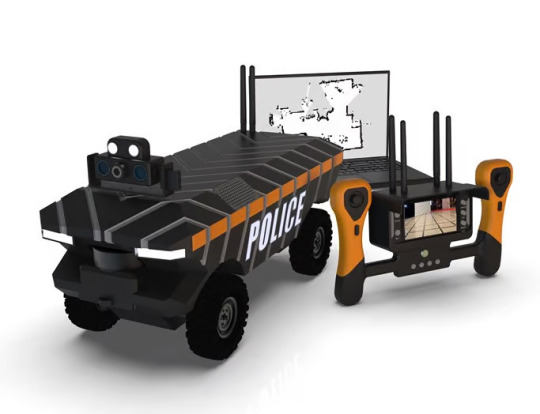
Project ROVER is a new robotic platform that is being developed in collaboration with Global Communication Services, GEC Engineering, WVLT, and Project ROVER for law enforcement and emergency use. ROVER is a small, four-wheeled robot that is equipped with a variety of sensors, devices, components and capabilities, including:
BLE tracking: ROVER can follow officers into a building using Bluetooth Low Energy (BLE) technology. This allows officers to enter a building without having to worry about losing track of their robot. This follow-behind technology allows an operator in a command center to see live video of officer movement and situational awareness.
Live camera view: ROVER can provide an operator outside a building with a live camera view of the environment. This allows the operator to see what the robot is seeing and to give the robot commands.
Software Defined RF Grid Mapping: ROVER can do RF Grid Mapping, which logs the RF signal strength against the LiDAR at points within the grid. This can be used to identify areas of poor RF coverage or to map out the location of radio-emitting devices.
Software Defined Deployable bi-directional amplifier: ROVER can act as a deploy-able bi-directional amplifier for Land Mobile Radios in the 100MHZ to 3.2GHZ range. This can be used to improve the signal strength of radios in areas with poor reception.
Software Defined Capabilities to stand up a ad-hoc cellular network for use to locate individuals during search and rescue missions.
ROVER is a versatile platform that can be used for a variety of law enforcement tasks, including:
Search and rescue: ROVER can be used to search for missing persons or victims of natural disasters.
Patroling: ROVER can be used to patrol areas that are difficult or dangerous for officers to access, such as high-crime areas or areas with hazardous materials.
Evidence collection: ROVER can be used to collect evidence from crime scenes.
Disaster response: ROVER can be used to help with disaster response efforts.
Active Shooter Response: ROVER can be deployed to assist in active shooter response by providing live video, LiDAR mapping, and in-building radio coverage enhancement.
ROVER is still under development, but it has the potential to be a valuable tool for law enforcement. It is a versatile platform that can be used for a variety of tasks, and it can help to improve officer safety and effectiveness.
How ROVER Works
ROVER is powered by a lithium-ion battery and has a top speed of 5 mph. It is equipped with a variety of sensors, including a 360-degree camera, a LiDAR scanner, a BLE receiver, and a software-defined radio provided by WVLT..
The 360-degree camera allows ROVER to see its surroundings in all directions. The LiDAR scanner allows ROVER to create a 3D map of its environment. The BLE receiver allows ROVER to follow officers using BLE technology. The software-defined radio allows ROVER to do RF Grid Mapping and to act as a deploy-able bi-directional amplifier.
ROVER is controlled by an operator who uses a remote control. The operator can use the remote control to move ROVER around, to pan and tilt the camera, and to give ROVER commands.
Benefits of Using ROVER
There are a number of benefits to using ROVER, including:
Increased officer safety: ROVER can help to increase officer safety by allowing officers to enter dangerous or hazardous environments without having to put themselves at risk.
Improved situational awareness: ROVER can help to improve officer situational awareness by providing officers with a live camera view of the environment. This can help officers to identify potential threats and to make better decisions.
Increased efficiency: ROVER can help to increase officer efficiency by allowing officers to focus on other tasks, such as investigating a crime scene or providing medical assistance.
Conclusion
Project ROVER is a new robotic platform that has the potential to be a valuable tool for law enforcement. It is a versatile platform that can be used for a variety of tasks, and it can help to improve officer safety and effectiveness.
· Official website of the project: https://www.roverrobot.org/
· The official website of the project on LinkedIn: https://www.linkedin.com/company/project-rover-inc/about/
· Leaders and members of the company:
· Brian Martin CEO: https://www.linkedin.com/in/brian-martin--/
· Dhruv A. — director: https://www.linkedin.com/in/dhruv-a-72662166/
· Mike Matranga — President: https://www.linkedin.com/in/mike-matranga-23b59427/
· Anthony Ferguson — Secretary: https://www.linkedin.com/in/anthony-j-ferguson/
· Engineering Team CTO: https://www.linkedin.com/in/oleg-gridin-74563a226/
· Engineering team: https://gec-engineering.tech/about-us/
2 notes
·
View notes
Text
How Bluetooth Access Control Systems Are Revolutionizing Entry Management
In a rapidly evolving digital world, security and convenience are no longer mutually exclusive—especially when it comes to access control. Traditional systems that rely on physical keys, access cards, or keypads are giving way to smarter, more efficient alternatives. At the forefront of this transformation are Bluetooth access control systems, redefining how we manage entry to offices, co-working spaces, buildings, and even residential properties.

These systems are more than just a technological upgrade; they represent a new philosophy—one that prioritizes user experience, mobile integration, and real-time management. As the need for scalable, secure, and touchless access increases, Bluetooth-based solutions are becoming the go-to choice for modern organizations.
What Are Bluetooth Access Control Systems?
Bluetooth access control systems use Bluetooth Low Energy (BLE) technology to facilitate secure entry through smartphones. Instead of using physical cards or fingerprint scanners, users simply use a mobile app to gain access to a space. These systems communicate with smart locks or readers that are installed at entry points and authenticate users based on digital credentials stored securely in their devices.
Unlike older methods, Bluetooth systems don’t require users to even unlock their phone in some cases. With proximity-based entry, doors open automatically when the authorized user approaches, making the process seamless and highly efficient.
Why Bluetooth Access Control is Gaining Popularity
1. Touchless Convenience
One of the biggest drivers behind the rise of Bluetooth access control systems is the demand for contactless interactions, especially in the wake of the COVID-19 pandemic. With health and hygiene being a top concern, businesses and property managers are looking for ways to reduce physical touchpoints.
Bluetooth-based access ensures that users can enter a space without touching keypads, shared cards, or door handles—just their phone in their pocket or hand. This touchless convenience has become a hallmark of smart entry systems.
2. Mobile-First Management
Smartphones have become the central hub for both personal and professional life. Bluetooth access systems leverage this reality by making the mobile phone the digital key to every door. Administrators can manage permissions, monitor entries, and revoke access—all from a centralized cloud-based dashboard.
Need to give someone temporary access to a space? You can send digital credentials via a mobile app. This level of flexibility and real-time control is far superior to managing physical keys or cards.
3. Improved Security
Security is the primary purpose of any access control system, and Bluetooth-based systems elevate it further. Traditional methods are vulnerable to duplication or loss—access cards can be cloned, and keys can be stolen. But digital credentials are far more secure, often encrypted and stored within secure containers on users’ phones.
Additionally, these systems often integrate with multi-factor authentication or biometric verification, adding an extra layer of protection.
4. Scalability for Growing Businesses
As businesses expand, so do their security needs. Bluetooth access control systems are inherently scalable. Whether you have a small team in a single office or hundreds of employees across multiple locations, these systems grow with you.
With cloud integration, access rights can be adjusted instantly, and all activity logs are available in real-time, no matter where the administrator is. This makes them an excellent solution for growing startups, co-working spaces, and large enterprises alike.
5. Cost-Effective in the Long Run
While there might be an initial investment in installing smart locks and readers, Bluetooth access systems can save money in the long run. There are no costs associated with lost keys or damaged access cards, and administrators spend less time managing credentials manually.
The use of a cloud-based platform also reduces the need for expensive on-site servers or hardware infrastructure, leading to more streamlined operations and better ROI.
Real-World Applications Across Industries
From tech parks in Bengaluru to co-working hubs in Mumbai, Bluetooth access control systems are being embraced across various sectors:
Corporate offices are adopting mobile access to enhance employee experience and reduce admin workloads.
Residential buildings use it to simplify visitor entry and enhance community security.
Educational institutions benefit from controlling student and staff access in real time.
Healthcare facilities use it to restrict access to sensitive zones without compromising hygiene.
The use cases are diverse, and the benefits are tangible, especially when paired with smart building ecosystems.
Choosing the Right Bluetooth Access Control System
If you're considering making the switch, it's important to choose a system that offers:
Seamless mobile integration for iOS and Android devices
Cloud-based management for real-time control and updates
Offline functionality to ensure access during network issues
Secure data encryption and compliance with privacy regulations
Scalable design that supports multi-location management
Providers who understand these evolving needs are designing solutions that blend security with simplicity. While the market offers several options, it’s worth exploring platforms that are built with a mobile-first mindset and prioritize both user and admin experience.
One such example comes from a leading provider known for redefining the access control landscape with innovative, wireless, and cloud-based systems. With a focus on mobile credentials, touchless access, and integration with attendance and visitor management, these solutions are particularly suited for modern Indian workspaces. It's this level of innovation that’s driving adoption across sectors.
Conclusion
Bluetooth access control systems are not just a technological trend—they are a strategic investment for businesses seeking smarter, more secure, and user-friendly entry solutions. As workplaces evolve and security demands become more complex, it’s clear that mobile-enabled, cloud-powered access systems are the future.
For any business looking to modernize their infrastructure without compromising on security or user experience, now is the time to explore what Bluetooth access control has to offer. Innovative platforms like Spintly are already leading the way in transforming how organizations manage access—combining the power of mobility, wireless technology, and cloud intelligence. The right system doesn’t just open doors—it opens possibilities.
#bluetooth#mobile access#spintly#accesscontrol#smartacess#biometrics#smartbuilding#access control system#visitor management system#access control solutions#biometric attendance
0 notes
Text
10 Innovative Ways of Attendee Tracking at Events
Attendee tracking has evolved significantly, allowing event organizers to streamline operations, enhance security, and elevate attendee experience. For event companies in Dubai, where the demand for seamless events is high, employing innovative attendee tracking methods is crucial. In this blog, we delve into 10 effective ways event companies can employ attendee tracking to optimize their events.

1. QR Codes for Seamless Check-Ins
QR codes have revolutionized the check-in process at events. Event organizers can generate unique QR codes for each attendee, which they can then scan upon arrival using smartphones or dedicated scanners. This method expedites the check-in process, reducing wait times and enhancing overall attendee satisfaction.
2. RFID Technology for Precise Tracking
Radio-frequency identification (RFID) technology enables precise tracking of attendees throughout the event venue. By issuing RFID-enabled badges or wristbands, event companies in Dubai monitor attendees' movements in real-time, gather valuable insights into foot traffic patterns, and optimize event layouts for better flow and engagement.
3. Event Platforms and Event Apps
Leveraging event platforms and dedicated apps allows event organizers to facilitate seamless attendee tracking. These platforms enable attendees to create personalized schedules, interact with speakers and other participants, and provide valuable feedback. By analyzing app usage data, event organizers can gain insights into attendee preferences and behavior.
4. Event Registration Software
Event registration software streamlines the registration process while capturing essential attendee data. From basic contact information to dietary preferences and session preferences, registration software allows event organizers to gather comprehensive data, which can be utilized for targeted communication and personalized experiences.
5. Geofencing for Location-Based Engagement
Geofencing technology enables event organizers to create virtual boundaries around specific areas within the event venue. By sending targeted notifications to attendees' smartphones when they enter or exit these zones, event organizers can deliver relevant information, promotions, or session reminders, enhancing attendee engagement and participation.
6. Biometric Authentication for Enhanced Security
Biometric authentication, such as fingerprint or facial recognition, offers a secure and convenient way to verify attendees' identities. By integrating biometric authentication into check-in processes or access control systems, event managers can enhance security measures while providing a frictionless experience for attendees.
7. Social Media Integration for Amplified Reach
Integrating social media platforms into attendee tracking systems allows event organizers to amplify their event's reach and engagement. By encouraging attendees to share their experiences, photos, and insights on social media using event-specific hashtags or handles, organizers can generate buzz and attract a broader audience both during and after the event.
8. Beacon Technology for Personalized Experiences
Beacon technology utilizes Bluetooth Low Energy (BLE) to transmit signals to nearby smartphones, enabling personalized interactions based on proximity. Event companies deploy beacons strategically throughout the venue to deliver tailored content, promotions, or recommendations based on attendees' locations and preferences.
9. Virtual Reality (VR) and Augmented Reality (AR) Experiences
Incorporating VR and AR experiences into events provides unique opportunities for attendee tracking and engagement. By offering virtual tours, interactive exhibits, or gamified experiences, organizers can capture valuable data on attendees' interactions and preferences, allowing for targeted follow-ups and personalized recommendations.
10. Data Analytics for Continuous Improvement
Harnessing the power of data analytics allows event organizers to derive actionable insights from attendee tracking data. By analyzing metrics such as attendance rates, session popularity, dwell times, and engagement levels, organizers can identify areas for improvement, refine future event strategies, and deliver exceptional experiences tailored to attendees' needs and preferences.
In Conclusion
Attendee tracking plays a pivotal role in shaping the success of events, particularly for event companies in Dubai striving to deliver world-class experiences. By leveraging innovative technologies and data-driven approaches, organizers can optimize event operations, enhance attendee engagement, and ultimately, create memorable experiences that resonate long after the event concludes. Embracing these 10 ways of attendee tracking will not only elevate events but also set new standards for excellence in the industry.
0 notes
Text
This Week in Rust 538
Hello and welcome to another issue of This Week in Rust! Rust is a programming language empowering everyone to build reliable and efficient software. This is a weekly summary of its progress and community. Want something mentioned? Tag us at @ThisWeekInRust on Twitter or @ThisWeekinRust on mastodon.social, or send us a pull request. Want to get involved? We love contributions.
This Week in Rust is openly developed on GitHub and archives can be viewed at this-week-in-rust.org. If you find any errors in this week's issue, please submit a PR.
Updates from Rust Community
Official
Announcing Rustup 1.27.0
crates.io: Download changes
Newsletters
This Month in Rust OSDev: February 2024
Project/Tooling Updates
Bevy Foundation
Rust Flashcards - 557 cards to learn Rust from first principles
Lib.rs website improvements
Sudo-rs dependencies: when less is better
rust-analyzer changelog #224
biscotti, a new crate for HTTP cookies
Boa release v0.18
Announcing Relm4 0.7 and 0.8
Meilisearch 1.7 — New OpenAI models & GPU support for Hugging Face embeddings
Cargo wizard: automate Cargo project configuration
GreptimeDB v0.7 is ready for cloud-native monitoring
[video] Project Syn - Simon Gerber - Rust Zürisee March 2024
Observations/Thoughts
Fast Development In Rust, Part One
Mental model for unsafe (complete rewrite)
10 years in Open Source
[audio] Season Finale - Rust in Production Podcast
[video] SemVer in Rust: Breakage, Tooling, and Edge Cases
Rust Walkthroughs
How to Use Rust Procedural Macros to Replace Panic with syn’s Fold
Rust Iterators Beyond the Basics - part 1
Rust Multi-crate project in a monorepo
Using Stripe Payments with Rust
Problems around modelling an asynchronous API for database transaction in Rust
Embedded Rust Bluetooth on ESP: BLE Scanner
[video] Implementing (parts of) git from scratch in Rust
[video] The Billion Rows Challenge in Rust - an intro to Rust for data engineering
Miscellaneous
Rust impact on engineering management
From medical doctor to rust developer
February 2024 Rust Jobs Report
Crate of the Week
This week's crate is biscotti, an opinionated library to deal with HTTP cookies on the server side.
We saw a lamentable lack of suggestions this week. Nevertheless, llogiq is pleased with his selection.
Please submit your suggestions and votes for next week!
Call for Testing
An important step for RFC implementation is for people to experiment with the implementation and give feedback, especially before stabilization. The following RFCs would benefit from user testing before moving forward:
Tracking Issue for min_exhaustive_patterns
Testing Steps
If you are a feature implementer and would like your RFC to appear on the above list, add the new call-for-testing label to your RFC along with a comment providing testing instructions and/or guidance on which aspect(s) of the feature need testing.
Call for Participation; projects and speakers
CFP - Projects
Always wanted to contribute to open-source projects but did not know where to start? Every week we highlight some tasks from the Rust community for you to pick and get started!
Some of these tasks may also have mentors available, visit the task page for more information.
Hyperswitch - [REFACTOR]: Remove Default Case Handling - Bambora
Hyperswitch - [REFACTOR]: Remove Default Case Handling - Mollie
Hyperswitch - [REFACTOR]: Remove Default Case Handling - Braintree
GreptimeDB - Painless integrating with Grafana via Prometheus plugin
GreptimeDB - Add strict mode to validate protocol strings
Fluvio - fvm switch fails on some systems with running local cluster
Fluvio - Add new command fluvio cluster resume
quinn - Add CI for mobile platforms (iOS & Android)
If you are a Rust project owner and are looking for contributors, please submit tasks here.
CFP - Speakers
Are you a new or experienced speaker looking for a place to share something cool? This section highlights events that are being planned and are accepting submissions to join their event as a speaker. They are ordered below by when the CFP closes.
RustFest Zürich 2024 | Closes 2024-03-31 | Zürich, Switzerland | Event date: 2024-06-19 - 2024-06-24
Oxidize 2024 | Closes 2024-03-24 | Berlin, Germany | Event date: 2024-05-28 - 2024-05-30
RustConf 2024 | Closes 2024-04-25 | Montreal, Canada | Event date: 2024-09-10
EuroRust 2024| Closes 2024-06-03 | Vienna, Austria & online | Event on 2024-10-10
Scientific Computing in Rust 2024| Closes 2024-06-14 | online | Event date: 2024-07-17 - 2024-07-19
If you are an event organizer hoping to expand the reach of your event, please submit a link to the submission website through a PR to TWiR.
Updates from the Rust Project
506 pull requests were merged in the last week
add new Tier-3 target: loongarch64-unknown-linux-musl
add arm64ec-pc-windows-msvc target
LLVM Bitcode Linker: A self contained linker for nvptx and other targets
AST validation: Improve handling of inherent impls nested within functions and anon consts
const_eval_select: make it safe but be careful with what we expose on stable for now
hir_analysis: enums return None in find_field
add a description field to target definitions
add an option to have an external download/bootstrap cache
add asm goto support to asm!
add metadata to targets
add proper cfgs for struct HirIdValidator used only with debug-assert
add the new description field to Target::to_json, and add descriptions for some MSVC targets
allow codegen backends to opt-out of parallel codegen
allow multiple impl Into<{D,Subd}iagMessage> parameters in a function
allow targets to override default codegen backend
apply EarlyBinder only to TraitRef in ImplTraitHeader
avoid invoking the intrinsic query for DefKinds other than Fn or AssocFn
avoid overlapping privacy suggestion for single nested imports
change some attributes to only_local
check that return type is WF in typeck
detect unused struct impls pub trait
diagnostics: do not suggest using #[unix_sigpipe] without a value
distinguish between library and lang UB in assert_unsafe_precondition
do not try to format removed files
don't ICE if we collect no RPITITs unless there are no unification errors
don't ICE in CTFE if raw/fn-ptr types differ
don't pass a break scope to Builder::break_for_else
don't require specifying unrelated assoc types when trait alias is in dyn type
dynamically size sigaltstk in std
errors: share SilentEmitter between rustc and rustfmt
fix crash in internal late lint checking
fix legacy numeric constant diag items
fix linting paths with qself in unused_qualifications
fix metadata for dyn-star in new solver
fix misaligned loads when loading UEFI arg pointers
fix redundant import errors for preload extern crate
fix type resolution of associated const equality bounds (take 2)
fix: localWaker memory leak and some stability attributes
implement async closure signature deduction
improve diagnostics for parenthesized type arguments
interpret: do not call machine read hooks during validation
limit the number of names and values in check-cfg diagnostics
lint singleton gaps after exclusive ranges
loongarch: add frecipe and relax target feature
lower transmutes from int to pointer type as gep on null
make TAITs and ATPITs capture late-bound lifetimes in scope
make DefiningAnchor::Bind only store the opaque types that may be constrained, instead of the current infcx root item
make std::os::unix::ucred module private
make not finding core a fatal error
make the lowering of thir::ExprKind::If easier to follow
match lowering: define a convenient struct
only compare ambiguity item that have hard error
only set noalias on Box with the global allocator
record mtime in bootstrap's LLVM linker script
refactor pre-getopts command line argument handling
refer to "slice" instead of "vector" in Ord and PartialOrd trait impl of slices
remove feed_local_def_id
removing absolute path in proc-macro
rework untranslatable_diagnostic lint
run a single huge par_body_owners instead of many small ones after each other
silence mismatched types errors for implied projections
stabilize the #[diagnostic] namespace and #[diagnostic::on_unimplemented] attribute
std support for wasm32 panic=unwind
store backtrace for must_produce_diag
temporarily make allow-by-default the non_local_definitions lint
tweak the way we protect in-place function arguments in interpreters
uplift some feeding out of associated_type_for_impl_trait_in_impl and into queries
use GEP inbounds for ZST and DST field offsets
use ptradd for vtable indexing
MIR printing: print the path of uneval'd const
miri: do not apply aliasing restrictions to Box with custom allocator
miri: remove the ability to disable ABI checking
perf: build rustc with 1CGU on x86_64-apple-darwin and x86_64-pc-windows-msvc
replace the default branch with an unreachable branch If it is the last variant
optimize write with as_const_str for shorter code
fix quadratic behavior of repeated vectored writes
net: don't use checked arithmetic when parsing numbers with known max digits
align_offset, align_to: no longer allow implementations to spuriously fail to align
impl From<TryReserveError> for io::Error
make impl<Fd: AsFd> impl take ?Sized
add Read impl for &Stdin
std::rand: enable getrandom for dragonflybsd too
std::threads: revisit stack address calculation on netbsd
win10: use GetSystemTimePreciseAsFileTime directly
windows: implement condvar, mutex and rwlock using futex
add slice::try_range
implement MaybeUninit::fill{,_with,_from}
RawVec::into_box: avoid unnecessary intermediate reference
Vec::try_with_capacity
add #[inline] to BTreeMap::new constructor
add std::ffi::c_str module
futures: add a helper for always ready futures
cargo: cli: allow logging to chrome traces
cargo: doc: collapse down generated statuses without --verbose
cargo: log: trace parameters to align with profile
cargo: lockfile: make diffing/printing more reusable
cargo: consistently compare MSRVs
rustfmt: fix failure with => in comment after match =>
clippy: new lints: duplicated_attributes, manual_unwrap_or_default, nonminimal_bool, zero_repeat_side_effects and const_is_empty
clippy: fix duplicate diagnostics in manual_retain, mut_mut, no_effect_replace and single_match
clippy: don't lint redundant_field_names across macro boundaries
clippy: fix std_instead_of_core false positive
clippy: fix missing_docs_in_private_items on some proc macros
clippy: have more lints respect #[allow] on exprs
rust-analyzer: add QuickFix for unresolved field
rust-analyzer: add fix for unused_variables
rust-analyzer: add proc macro semantic token type
rust-analyzer: add config and capability for test explorer
rust-analyzer: don't escape \ and $ in "Extract format expressions" assist
rust-analyzer: don't force draw a dependency edge to the real_span_map query
rust-analyzer: don't invalid body query results when generating desugared names
rust-analyzer: fix method resolution snapshotting receiver_ty too early
rust-analyzer: function argument type inference with associated type impl trait
rust-analyzer: keep attributes in assist 'generate_delegate_trait'
rust-analyzer: panic when using float numbers without dots in chain calls
rust-analyzer: preserve $ and \ in postfix format completions
rust-analyzer: remove accidental dependency between parse_macro_expansion and parse
rust-analyzer: skip match diagnostics for partially unknown types
rust-analyzer: for toolchain binaries use the full path found in $PATH
rust-analyzer: stop eagerly resolving inlay hint text edits for VSCode
Rust Compiler Performance Triage
A mixed week, with a vast number of improvements (in large part due to PR
122010, which undoes a prior regression; PR #120985, a host LLVM update).
But also three admittedly small-ish regressions which seemed unanticipated and were still large enough that I did not feel comfortable rubber-stamping them with a perf-regression-triaged marking.
Triage done by @pnkfelix. Revision range: 41d97c8a..e919669d
2 Regressions, 5 Improvements, 9 Mixed; 5 of them in rollups 54 artifact comparisons made in total
Full report here
Approved RFCs
Changes to Rust follow the Rust RFC (request for comments) process. These are the RFCs that were approved for implementation this week:
RFC: Packages as (optional) namespaces
Final Comment Period
Every week, the team announces the 'final comment period' for RFCs and key PRs which are reaching a decision. Express your opinions now.
RFCs
No RFCs entered Final Comment Period this week.
Tracking Issues & PRs
Rust
[disposition: merge] Normalize trait ref before orphan check & consider ty params in alias types to be uncovered
[disposition: merge] Split refining_impl_trait lint into _reachable, _internal variants
[disposition: merge] debuginfo: Stabilize -Z debug-macros, -Z collapse-macro-debuginfo and #[collapse_debuginfo]
[disposition: merge] Stabilize associated type bounds (RFC 2289)
[disposition: merge] c_unwind full stabilization request: change in extern "C" behavior
[disposition: postpone] Consider linting against 00B7 aka interpunct aka middle dot
[disposition: merge] Prevent opaque types being instantiated twice with different regions within the same function
[disposition: merge] instantiate higher ranked goals outside of candidate selection
[disposition: merge] Add wasm_c_abi future-incompat lint
[disposition: merge] stabilize ptr.is_aligned, move ptr.is_aligned_to to a new feature gate
[disposition: merge] feat: implement {Div,Rem}Assign<NonZero<X>> on X
Cargo
[disposition: merge] cargo: prevent dashes in lib.name
New and Updated RFCs
[new] Make cargo install respect lockfiles by default
Upcoming Events
Rusty Events between 2024-03-13 - 2024-04-10 🦀
Virtual
2024-03-14 | Virtual (Berlin, DE) | OpenTechSchool Berlin
Web Frontend Co-Learning (online)
2024-03-14 | Virtual (Berlin, DE) | OpenTechSchool Berlin + Rust Berlin
Rust Hack and Learn | Mirror: Rust Hack n Learn Meetup | Mirror: Berline.rs page
2024-03-14 | Virtual (Nürnberg, DE) | Rust Nüremberg
Rust Nürnberg online
2024-03-14 | Virtual (San Diego, CA, US) | San Diego Rust
San Diego Rust March 2024 Tele-Meetup
2024-03-19 | Virtual | Formal Land
Rust for Lunch: Formal verification for Rust with coq-of-rust. Speaker: Guillaume Claret | Docs
2024-03-19 | Virtual (Washinigton, DC, US) | Rust DC
Mid-month Rustful
2024-03-20 | Virtual (Cardiff, UK) | Rust and C++ Cardiff
Rust for Rustaceans Book Club: Chapter 3 - Designing Interfaces
2024-03-20 | Virtual (Vancouver, BC, CA)| Vancouver Rust
Rust Study/Hack/Hang-out
2024-03-21 | Virtual (Charlottesville, NC, US) | Charlottesville Rust Meetup
Crafting Interpreters in Rust Collaboratively
2024-03-26 | Virtual + In Person (Barcelona, ES) | BcnRust
13th BcnRust Meetup - Stream
2024-03-26 | Virtual (Dallas, TX, US) | Dallas Rust
Last Tuesday
2024-03-28 | Virtual + In Person (Berlin, DE) | OpenTechSchool Berlin + Rust Berlin
Rust Hack and Learn | Mirror: Rust Hack n Learn Meetup
2024-04-02 | Virtual (Buffalo, NY, US) | Buffalo Rust
Buffalo Rust User Group
2024-04-03 | Virtual (Cardiff, UK) | Rust and C++ Cardiff
Rust for Rustaceans Book Club: Chapter 4 - Error Handling
2024-04-03 | Virtual (Indianapolis, IN, US) | Indy Rust
Indy.rs - with Social Distancing
2024-04-09 | Virtual (Dallas, TX, US) | Dallas Rust
Second Tuesday
Africa
2024-04-05 | Kampala, UG | Rust Circle Kampala
Rust Circle Meetup
Asia
2024-03-30 | New Delhi, IN | Rust Delhi
Rust Delhi Meetup #6
Europe
2024-03-13 | Paris, FR | Paris Rustaceans
Rust Meetup in Paris
2024-03-14 | Reading, UK | Reading Rust Workshop
Reading Rust Meetup at Browns
2024-03-19 | Aarhus, DK | Rust Aarhus
Hack Night
2024-03-19 | Leipzig, DE | Rust - Modern Systems Programming in Leipzig
Rust Interactive Session
2024-03-19 | Prague, CZ | Rust Prague
Rust Meetup @ Charles University
2024-03-20 | Girona, ES | Rust Girona
Introduction to programming Microcontrollers with Rust
2024-03-20 | Lyon, FR | Rust Lyon
Rust Lyon Meetup #9
2024-03-21 | Augsburg, DE | Rust Meetup Augsburg
Augsburg Rust Meetup #6
2024-03-21 | Lille, FR | Rust Lille
Rust Lille #6: Du RSS et de L'ECS !
2024-03-21 | Vienna, AT | Rust Vienna
Rust Vienna Meetup - March - Unsafe Rust
2024-03-23 | Stockholm, SE | Ferris' Fika Forum
Ferris' Fika Forum | Map
2024-03-26 | Barcelona, ES + Virtual | BcnRust
13th BcnRust Meetup
2024-03-26 - 2024-03-28 | London, UK | Rust Nation UK
Rust Nation 2024 - Conference
2024-03-28 | Berlin, DE | Rust Berlin
Rust and Tell
2024-04-10 | Cambridge, UK | Cambridge Rust Meetup
Rust Meetup Reboot 3
2024-04-10 | Oslo, NO | Rust Oslo
Rust Hack'n'Learn at Kampen Bistro
North America
2024-03-13 | Boston, MA, US | Boston Rust Meetup
Northeastern Rust Lunch
2024-03-19 | San Francisco, CA, US | San Francisco Rust Study Group
Rust Hacking in Person
2024-03-21 | Seattle, WA, US | Seattle Rust User Group
Seattle Rust User Group Meetup
2024-03-22 | Somerville, MA, US | Boston Rust Meetup
Somerville Union Square Rust Lunch, Mar 22
2024-03-26 | Minneapolis, MN, US | Minneapolis Rust Meetup
Minneapolis Rust: Getting started with Rust!
2024-03-27 | Austin, TX, US | Rust ATX
Rust Lunch - Fareground
2024-03-27 | Hawthorne, CA, US | Freeform
Rust in the Physical World 🦀 Tech Talk Event at Freeform
2024-03-31 | Boston, MA, US | Boston Rust Meetup
Beacon Hill Rust Lunch, Mar 31
If you are running a Rust event please add it to the calendar to get it mentioned here. Please remember to add a link to the event too. Email the Rust Community Team for access.
Jobs
Please see the latest Who's Hiring thread on r/rust
Quote of the Week
In 10 years we went from “Rust will never replace C and C++” to “New C/C++ should not be written anymore, and you should use Rust”. Good job.
– dpc_pw on lobste.rs
Thanks to Dennis Luxen for the suggestion!
Please submit quotes and vote for next week!
This Week in Rust is edited by: nellshamrell, llogiq, cdmistman, ericseppanen, extrawurst, andrewpollack, U007D, kolharsam, joelmarcey, mariannegoldin, bennyvasquez.
Email list hosting is sponsored by The Rust Foundation
Discuss on r/rust
1 note
·
View note
Text
Der ESP32 Plus von Keyestudio: Ein leistungsstarker Mikrocontroller im Arduino-UNO-Format

Bist du bereit, in die faszinierende Welt der Mikrocontroller einzutauchen? Dann lass mich dir den ESP32 Plus von Keyestudio vorstellen - ein wahres Powerpaket im beliebten Arduino UNO R3-Format. In diesem Beitrag werde ich dir zeigen, warum der ESP32 Plus mit seinen zahlreichen Vorteilen und Funktionen den Arduino UNO R3 in den Schatten stellt. Also schnall dich an und lass uns loslegen!
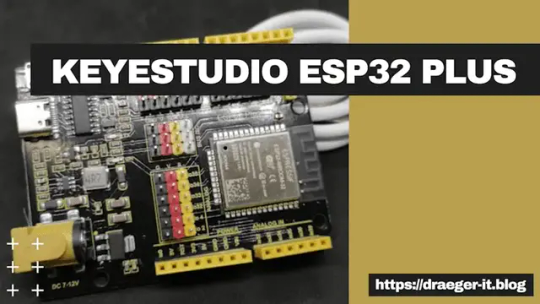
Technische Daten des ESP32 Plus von Keyestudio
Auf dem ESP32 Plus von Keyestudio ist ein ESP32-WROOM-32 verbaut von Espressif verbaut, welcher nachfolgende technische Daten hat: MikrochipDual-Core Tensilica LX6 mit 240 MHzSpeicher16 MB Flash, 520 KB SRAMBetriebsspannung3.3 VSchnittstellen4x SPI, 1x CAN 2.0, 2x I2C, 10x TouchDrahtlose SchnittstellenWiFi 802.11n mit bis zu 150 Mbps, Bluetooth 2.0 & Bluetooth Low Energy (BLE) 4.2GPIOs16 PWM Pins, insgesamt 36 digitale Pins, 16 analoge PinsTechnische Daten des ESP32-WROOM-32 Der Mikrocontroller ESP32 Plus verfügt zusätzlich über einen Jack-Adapter für die Spannungsversorgung von 7 bis 12V und eine USB-C Schnittstelle um diesen zu programmieren.
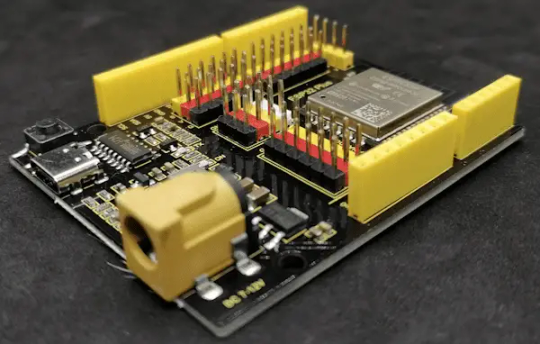
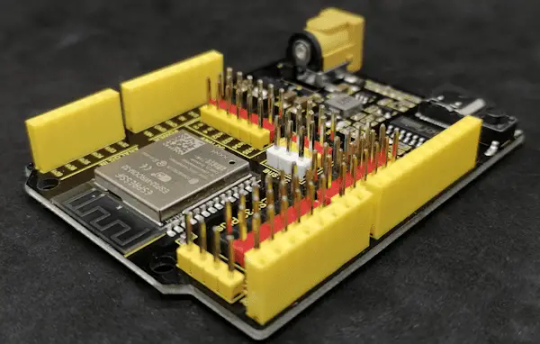
Aufbau des ESP32 Plus von Keyestudio
Wie erwähnt hat der Mikrocontroller den gleichen Formfaktor wie der Arduino UNO R3 jedoch hat dieser ein paar zusätzliche Pins bzw. Buchsen für GPIOs.
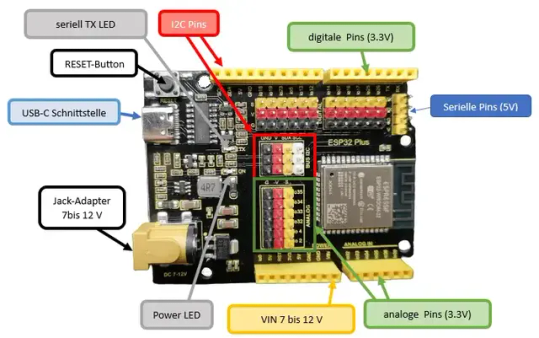
Aufbau des Mikrocontrollers ESP32 Plus von Keyestudio
Bezug eines ESP32 Plus
Das mir vorliegende Modell habe ich auf amazon.de für derzeit rund 12 € inkl. Versandkosten bezogen. Sicherlich ist der Preis für einen reinen ESP32 auf Plattformen wie aliexpress.com, banggood.com oder auch ebay.de deutlich günstiger, jedoch erhältst du mit diesem Mikrocontroller ein paar zusätzliche Features, welche den Preis wie ich finde, rechtfertigt. Lieferumfang Zum Lieferumfang gehört lediglich ein USB-C Datenkabel.

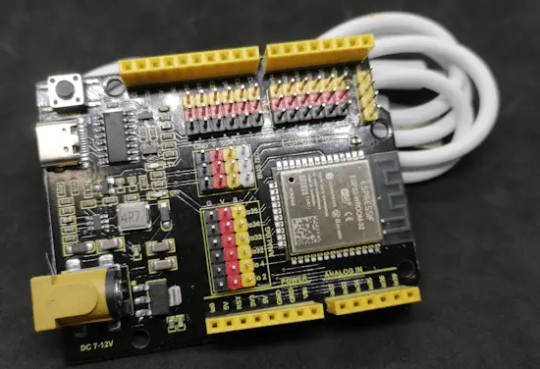
Vergleichen des ESP32 Plus von Keyestudio mit dem Arduino UNO R3
Wie man auf dem Bild erkennen kann, hat der ESP32 Plus die gleiche Größe und Aufbau wie der Arduino UNO R3. Damit kannst du quasi theoretische die gleichen Shields mit diesem verbinden.
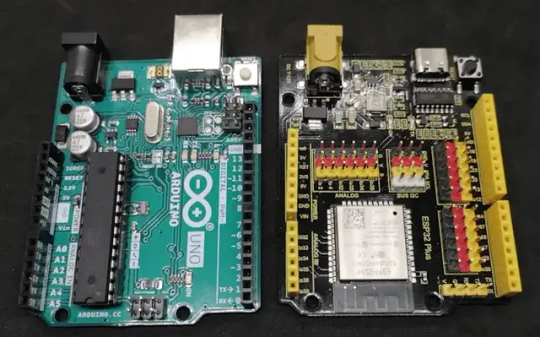
Es gibt auch Shields welche den ISP benötigen, hier muss man beim Aufstecken darauf achten das natürlich an der Stelle der ESP32 Chip sitzt.
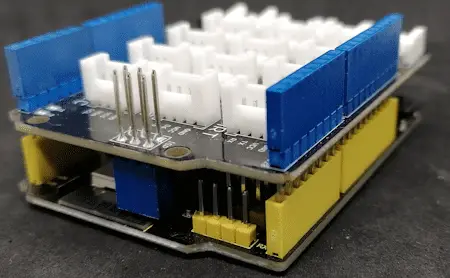
Du kannst jedoch mit etwas Aufwand deine Arduino UNO Projekte auf diesen Mikrocontroller sehr leicht umschreiben. Der Keyestudio ESP32 Plus hat mehrere I2C Pins, was die Möglichkeiten deutlich erweitert und du somit sehr viele Sensoren oder Aktoren anschließen kannst. Des Weiteren kannst du an die digitalen Pins sehr einfach auch Servomotoren aufstecken und brauchst diese nicht extra zu verkabeln. Du musst hier lediglich darauf achten, den Stecker korrekt aufzustecken!
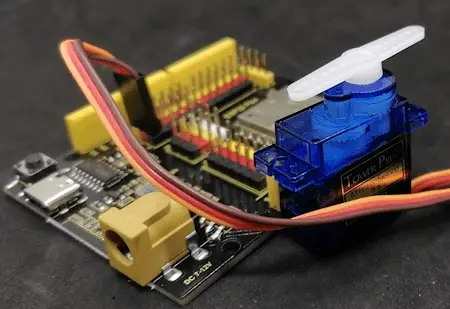
Servomotor SG90 am Keyestudio ESP32 Plus
Fehler "USB-Gerät wurde nicht erkannt." beim Anschluss an den Windows-PC
Beim Verbinden des Mikrocontrollers mit dem Windows-PC habe ich zunächst nachfolgende Fehlermeldung erhalten.

Fehlermeldung beim Anschluss des Mikrocontrollers ESP32 Plus an den Windows-PC Die Lösung zu dieser Fehlermeldung war recht einfach, denn ein Wechsel zum mitgelieferten USB-C Datenkabel führte zum erfolg. Warum dieser Mikrocontroller nicht das USB-C Datenkabel vom M5 Mikrocontroller verträgt, erschließt sich mich nicht sofort, soll aber nicht Scope dieses Beitrages sein. Auf dem DropBox Laufwerk von Keyestudio https://fs.keyestudio.com/KS5016 findest du ein Beispiel sowie die Treiber für den verbauten USB-Serial Chip CH340C.
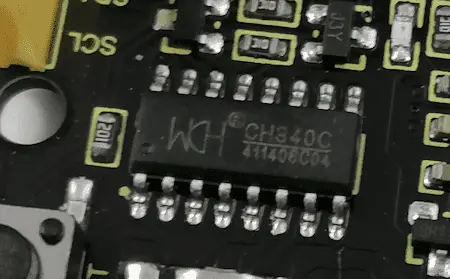
USB-Serial Converter -CH340C
Programmieren des ESP32 Plus in der Arduino IDE 2.0
In vergangenen Beiträgen habe ich dir bereits Projekte gezeigt, welche du mit dem ESP32 umsetzen kannst. Einen WiFi Scanner programmieren Im Dopbox Laufwerk von zum ESP32 Plus ist ein kleines Beispiel eines WiFi Scanners. #include "WiFi.h" void setup() { Serial.begin(115200); // Set WiFi to station mode and disconnect from an AP if it was previously connected WiFi.mode(WIFI_STA); WiFi.disconnect(); delay(100); Serial.println("Setup done"); } void loop() { Serial.println("scan start"); // WiFi.scanNetworks will return the number of networks found int n = WiFi.scanNetworks(); Serial.println("scan done"); if (n == 0) { Serial.println("no networks found"); } else { Serial.print(n); Serial.println(" networks found"); for (int i = 0; i < n; ++i) { // Print SSID and RSSI for each network found Serial.print(i + 1); Serial.print(": "); Serial.print(WiFi.SSID(i)); Serial.print(" ("); Serial.print(WiFi.RSSI(i)); Serial.print(")"); Serial.println((WiFi.encryptionType(i) == WIFI_AUTH_OPEN)?" ":"*"); delay(10); } } Serial.println(""); // Wait a bit before scanning again delay(5000); } Der Code scannt nach WiFi Netzwerken und listet diese mit der Stärke auf.

Da mein Büro im Keller und sehr abgeschirmt ist, habe ich lediglich mein kleines WiFi Netzwerk und mein Hotspot vom Handy. Read the full article
0 notes
Text
RadareEye - Scan Nearby devices [BLE, Bluetooth And Wifi]
RadareEye - Scan Nearby devices [BLE, Bluetooth And Wifi] #BLE #BLEScanner #Bluetooth #BluetoothLowEnergy #Command
A tool made for specially scanning nearby devices[BLE,Bluetooth & Wifi] and execute our given command on our system when the target device comes in between range. NOTE:- RadareEye Owner will be not responsible if any user performs malicious activities using this tool. Use it for Learning purpose only. Installation of RadareEye : git clone…

View On WordPress
#BLE#BLE Scanner#Bluetooth#Bluetooth Low Energy#Command#device#Devices#Execute#InBetween#mac#Nearby#Radare#RadareEye#Range#Scanning#Specially#System#Target#tool#wifi
2 notes
·
View notes
Text






Some pieces from unreleased Mar=ble magazine
2 notes
·
View notes
Text

NMEA 2000 Data Scanner with Bluetooth, BLE for Android, iOS, PC Applications
Our N2K-BT gateway functions as a NMEA 2000 to Bluetooth data scanner for any host device with a Bluetooth or BLE (Bluetooth Low Energy) port, such as PCs, phones, or tablets. Therefore, it supports operating systems such as Windows, Linux, iOS, Android, and more.
0 notes
Text
Smart Glove Market - Forecast (2021 - 2026)
The Smart Glove Market size is analyzed to grow at a CAGR of 9.6% during the forecast 2021-2026 to reach $4.67 billion by 2026. Smart Glove is considered as a wide range of Sensor technology gloves for advanced and customized solutions, such as hand protection, high-tech rehab device and other assistive device services. The Smart Gloves are designed electronic devices with microcontrollers to offer avant-garde opportunities for various kinds of application suitable to the business requirements, including industrial grade gloves and medical grade gloves, and thus, contribute to the Smart Glove market growth. The rapid prominence of the Internet of Things (IoT), artificial intelligence and connected devices, along with the increasing innovations in wearable health devices, smart personal protective equipment, integrated with GPS, wireless communication features and in-built voice assistance have supported the Smart Glove Industry development successfully. In fact, the growth of the market is also observed due to the growing advancement of the Bluetooth chip, flex sensors, microcontroller, and accelerometer. Furthermore, the progression of microencapsulation and nanotechnology pave the way for sensor technology which offers lucrative growth possibilities. The influx of brands like Samsung, Apple, and Fossil are broadening the functionalities, which further promotes Smart Glove Market.
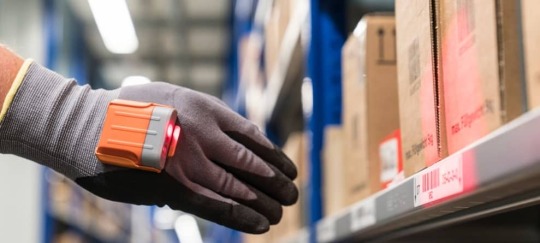
Smart Glove Market Report Coverage
The report: “Smart Glove Industry Outlook – Forecast (2021-2026)”, by IndustryARC covers an in-depth analysis of the following segments of the Smart Glove Industry.
By Offerings: Software and Service By Application: Fitness & Wellness, Specific Health Monitor, Infotainment, Ergonomic wearable and others By Industry Verticals: Pharmaceuticals & Healthcare, Food & Beverages, Enterprise and Industrial, Consumer Electronics and others By Geography: North America (U.S, Canada, Mexico), Europe (Germany, UK, France, Italy, Spain, Russia and Others), APAC(China, Japan, India, South Korea, Australia and Others), South America(Brazil, Argentina and others)and RoW (Middle east and Africa).
Request Sample
Key Takeaways
The growing demand of wearable medical devices owing to the increasing awareness on fitness and a healthy lifestyle along with prominence of connected devices in Healthcare, contribute to the growth.
Asia Pacific is estimated to hold the highest share of 40% in 2020, followed by North America, owing to the significant adoption of IoT, large scale implementation of a wide range of ubiquitous systems, such as wearable computing and sensor technology across the several business verticals.
The advancements in consumer electronics with a wide range of technical advantages, including touch sensitive features and miniature designs, resulted into the market growth.
Smart Glove Market Segment Analysis – By Industry Verticals
By Industry Verticals, the Smart Glove Market is segmented into Pharmaceuticals & Healthcare, Food & Beverages, Enterprise and Industrial, Consumer Electronics and others. The Enterprise and Industrial segment held the major share of 37% in 2020, owing to the propensity for cutting-edge products and significant investment to pursue radical evolutions in commercial applications. In order to address the growing requirement of several end users across automotive, oil & gas, manufacturing and logistics, customizable smart gloves with built-in scanners are introduced for more effective operations. In April 2019, the manufacturer of a smart, wearable technology, ProGlove, unveiled its MARK 2 to a U.S. audience ProMat in Chicago. The new MARK 2 enables the user to scan up to 5 feet away from a device and can connect to a corporate network via Bluetooth Low Energy (BLE), with up to 15-hour charge battery. ProGlove provides hands-free scanning solutions across a number of industries, and thus, in September 2020, Panasonic announced a partnership with ProGlove, to combine the mobile computing solutions of the two companies in order to offer rugged, innovative and user-friendly wireless barcode scanners. The strategic collaboration is also formulated to deliver seamless as-a-stand-alone scanning solution with an embedded Panasonic’s voice picking solutions for the warehouse operations, supply chain, and inventory checking. Therefore, the growing demand of integrated gesture sensor solutions for dynamic workstations, and a more efficient working environment accelerated the demand of Smart Glove Market.
Inquiry Before Buying
Smart Glove Market Segment Analysis – By Geography
Asia Pacific is estimated to hold the highest share of 40% in 2020, followed by North America in Smart Glove Market. The early adoption of IoT, large scale implementation of a wide range of ubiquitous systems, such as wearable computing and sensor technology across the several business verticals, along with the growing interest of consumers towards ‘sensorized’ fitness wearable devices are estimated to drive the market in these regions. Furthermore, numerous research investments propel the innovations of soft and stretchable electronics design that propel a competitive edge to smart wearable solutions. In January 2021, HaptX Inc. announced the release of HaptX Gloves DK2. The HaptX Gloves DK2 is an upgraded design and the world's most advanced haptic feedback gloves, which deliver unprecedented realism, with more than 130 points of tactile feedback per hand. These gloves have astoundingly real-life superpowers with VR, XR, and robotics technologies to meet the demand of various enterprises for quality requirements. Hence, the promising demand of industrial wearable and other smart personal protective equipment in these regions are estimated to drive the Smart Glove Market.
Smart Glove Market Drivers
Growing prominence of healthcare wearable
The growing demand of wearable medical devices owing to the increasing awareness on fitness and a healthy lifestyle along with prominence of connected devices in Healthcare, contribute to the growth of Smart Glove Market. Moreover, the rise of high-tech devices to usher clinical-grade wearable with 3G and 4G connection led to various viable solutions. In July 2020, UCLA bioengineers designed a glove-like device that can translate American Sign Language (ASL) into English speech in real time through a smartphone app. The entire system is integrated upon a pair of gloves with thin, stretchable sensors to translate hand gestures into spoken words. Hence, the sizable demand of personalized care, specific health issue monitoring devices and user-friendly, compact medical wearable propelled the growth of the Smart Glove Market.
Schedule a Call
Advancements in consumer electronics
The advancements in consumer electronics with a wide range of technical advantages, including touch sensitive features and miniature designs, resulted into the growth of Smart Glove Market. The advent of digitalization and latest development in sensor technology to enhance user performances is further driving the market. In April 2019, British music tech company Mi.Mu, founded by Grammy award-winning artist Imogen Heap announced the release of newly designed Mi.Mu gloves, allowing artists to map hand gestures to music software. The new gloves of Mi.Mu are durable with a removable battery system that offers artists complete control over their musical performances. Moreover, the breakthrough innovation in microfibre sensor technology offers strain sensing capabilities that provides gesture-based control. In August 2020, A team of researchers from the National University of Singapore (NUS), led by Professor Lim Chwee Teck, developed a smart glove, known as 'InfinityGloveTM', which enables users to mimic numerable in-game controls using simple hand gestures. Therefore, the launch of sophisticated wearable electronics products, extensive glove's capabilities and rising usage of convenient-to-use devices are some of the factors that are estimated to drive the Smart Glove Market.
Smart Glove Market Challenge
High price of Smart Glove solution
The market of Smart Glove is expanding due to the significant technologies development, using the amalgamation of sensing and feedback operation to denote smarter systems. Thus, the commercially available devices, pertaining to smart glove features are prominently expensive, which is a major constraint that demotivated the rapid adoption. Thus, factors such as less sensible investment and unobtainability of some of the latest smart gloves technology around some regions due to high cost are likely to restrict the Smart Glove Market.
Market Landscape
Partnerships and acquisitions along with product launches are the key strategies adopted by the players in the Smart Glove Market. The Smart Glove Market top 10 companies include Apple Inc, Flint Rehab, Haptx, Lab Brother Llc, Maze Exclusive, Neofect, Samsung Electronics Co Ltd, Seekas Technology Co., Ltd, Vandrico Solution Inc, ProGlove, Workaround Gmbh and among others
Buy Now
Acquisitions/Technology Launches/Partnerships
In December 2019, HaptX, the leading provider of realistic haptic technology announced the partnership with Advanced Input Systems along with a Series A financing round of $12 million. This acquisition provides a great opportunity for HaptX as they can finance the production of the next generation of HaptX Gloves, which represents the world’s most realistic gloves for virtual reality and robotics, coupled with product development, manufacturing, and go-to-market collaboration.
In November 2019, Ansell Limited, a leading provider of safety solutions, announced a partnership with ProGlove, a renowned industrial wearable manufacturer. The acquisition is formed to deliver advanced hand protection solutions to ensure the personal protective equipment (PPE) compliance in the workplace.
For more Electronics Market reports, please click here
#Smart Glove Market price#Smart Glove Market Forecast#Smart Glove Market Growth#Smart Glove Market Report#Smart Glove Market Research#Smart Glove Market Share#Smart Glove Market Size#Smart Glove Market Trend#Smart Glove Market Outlook
2 notes
·
View notes
Text
Best Asset tracking services
Asset tracking system provide solutions to the companies by the use of the ever-growing and efficient technology the data will be captured by hand held terminal at the point of activity .for more visit asset tracking solutions Complete asset tracking solution include barcode technology , it support companies in dubai enabling organization to scan their fixed assets to track them accurately and efficiently .Barcodes are the standard for data collection and asset tracking , giving each asset a unique it support companies in dubai identifier so that they may be individulaly asset tracking solutions recognized nad tracked.Bar code fro more visit it support companies in dubai based solution which enables the user capture accurate information at the point activity. scanner enabled mobile devices are used for data captures realted to assets at asset tracking solutions multiple location. track and control any type of asset .effective control of asset life cycles . Modularsied on premise it support companies in dubai or in the cloud with Moble Apps. Asset tracking refers to the method of tracking physical assets. either by scanning barcode labels attached to the assets or by using tags using GPS,BLE etc .which broadcast their locations. these technologies can also be used for indoor tracking of person wearing a tag.
1 note
·
View note
Link
Get your employees back to work in a safe environment!
CompanyTRAK uses real contact tracing to follow your employees through their daily interactions. If they have come in contact (CDC recommended distance) of another employee, we log it. If any employee reports symptoms or a positive test result, all employees that have been in contact with that employee and HR are notified of a possible exposure risk.
How It Works
With our patent pending, dual verification technology, CompanyTRAK uses real contact tracing to follow and log interaction of employees using a combination of mobile location services (GPS) and BLE technologies along with BT Beacons and scanners for places where cell phones can’t be used.
Our solution tracks both primary and secondary exposure and notifies employees and HR when another employee that they have been in contact with self-reports with symptoms or with positive test results.
Our algorithm manages and traces a real interaction to mark and notify employees when exposed.
#companytrak#companytrakapp#viral tracking app#virus tracking app#virus exposure tracking app#Contact Tracing App#virus exposure app
1 note
·
View note
Text
The Benefits of Switching from Attendance Punching Machines to Bluetooth Attendance Systems
In today’s fast-paced, technology-driven world, traditional attendance systems, such as attendance punching machines, are being replaced by more advanced and efficient alternatives. Bluetooth-based attendance systems are at the forefront of this transition, offering a plethora of benefits that enhance workforce management, security, and convenience. This blog delves into the key advantages of making the switch and why Bluetooth attendance systems are the future of attendance tracking.

The Limitations of Attendance Punching Machines
Attendance punching machines have long been a staple for workforce time tracking. These devices, while functional, come with several limitations:
Manual Errors: Employees may forget to punch in or out, leading to discrepancies in records.
Buddy Punching: This prevalent issue involves one employee clocking in on behalf of another, resulting in inaccurate data and productivity loss.
Wear and Tear: Physical components such as punch cards or biometric scanners in traditional machines are prone to damage over time, leading to frequent maintenance.
Inflexibility: Most punching machines lack the ability to integrate with modern workforce management tools.
While these systems have served their purpose, their shortcomings make them less effective in today’s digital era.
How Bluetooth Attendance Systems Work
Bluetooth attendance systems use Bluetooth Low Energy (BLE) technology to enable contactless attendance tracking. Employees can mark their attendance using their smartphones, which communicate with Bluetooth beacons placed at strategic locations within the workplace. These systems are often integrated with mobile applications, making them user-friendly and efficient.
Key Benefits of Bluetooth Attendance Systems
1. Enhanced Convenience
Unlike punching machines, Bluetooth systems allow employees to mark their attendance with their smartphones. This eliminates the need for physical interaction with a device, providing a faster and more seamless experience.
Employees don’t have to carry cards or memorize PINs.
The system operates automatically when they are within range of a Bluetooth beacon.
2. Increased Accuracy
Bluetooth systems reduce the chances of manual errors. The attendance is recorded automatically, ensuring data accuracy and minimizing discrepancies.
Automated timestamps provide precise records of entry and exit.
Real-time updates help HR teams track attendance instantly.
3. Elimination of Buddy Punching
With attendance linked directly to an employee’s smartphone, Bluetooth systems effectively eliminate buddy punching. Since access is tied to the individual device, only the rightful employee can mark attendance.
4. Scalability for Remote and Hybrid Workplaces
In the era of remote and hybrid work models, Bluetooth attendance systems provide unparalleled flexibility. Employees can log their attendance from designated locations, ensuring compliance without being physically present at the office.
Ideal for multi-location businesses and distributed teams.
Enables attendance tracking for on-site, remote, and hybrid employees with the same system.
5. Integration with Workforce Management Tools
Modern Bluetooth attendance systems integrate seamlessly with HR management platforms, payroll software, and analytics tools. This reduces administrative workload and improves overall efficiency.
Automates payroll calculations based on attendance data.
Provides insights into employee work patterns and productivity.
6. Contactless and Hygienic
The COVID-19 pandemic highlighted the importance of contactless solutions. Bluetooth systems allow employees to clock in and out without touching any shared device, ensuring hygiene and safety.
7. Cost-Effectiveness
While the initial investment in Bluetooth systems may seem higher, the long-term benefits far outweigh the costs.
Reduces maintenance expenses associated with physical punching machines.
Saves administrative time and resources.
8. Real-Time Monitoring and Alerts
Bluetooth systems enable real-time attendance tracking and notifications for HR teams and managers.
Alerts for late arrivals or early departures.
Instant reports on workforce attendance trends.
9. Future-Ready Technology
Bluetooth attendance systems are part of the broader Internet of Things (IoT) ecosystem. As workplaces become smarter, these systems can integrate with other IoT-enabled devices for a unified experience.
Industries Benefiting from Bluetooth Attendance Systems
From corporate offices to manufacturing units, the adaptability of Bluetooth attendance systems makes them ideal for various sectors:
Corporate Workplaces: Streamline attendance for on-site and hybrid employees.
Education: Simplify attendance tracking for staff and students.
Retail: Manage attendance across multiple stores.
Healthcare: Ensure secure and hygienic attendance tracking for medical personnel.
Making the Transition
Switching from an attendance punching machine to a Bluetooth attendance system is not just a technological upgrade — it’s a strategic decision that aligns with the needs of a modern workforce. Organizations considering this shift should evaluate solutions that offer:
Easy integration with existing systems.
Robust security features to protect data privacy.
Scalability to accommodate future growth.
For businesses looking for a trusted provider, platforms specializing in smart attendance and access control solutions offer innovative options tailored to diverse organizational needs.
Conclusion
Attendance punching machines, while effective in their time, are no match for the advanced capabilities of Bluetooth attendance systems. From eliminating buddy punching to enabling seamless integration with modern tools, Bluetooth systems redefine workforce management.
As organizations embrace digital transformation, investing in Bluetooth attendance solutions is a step toward greater efficiency, security, and employee satisfaction. By exploring options from reputable providers like Spintly in access and attendance solutions, businesses can ensure a smooth transition to this cutting-edge technology.
Bluetooth attendance systems aren’t just a trend — they’re the future of attendance management. If you’re ready to revolutionize how your organization tracks attendance, start exploring the possibilities today.
#accesscontrol#biometrics#smartacess#smartbuilding#spintly#mobile access#visitor management system#access control system#access control solutions
0 notes
Text
TAG AND BENEFIT TYPES FOR ASSETS
The advantages of each of the several sorts of tags are outlined below. some of which are more modern while others are more traditional.
Polypropylene Asset Tags
Polyester was used to make these items. These tags are very robust and adaptable for monitoring a variety of items and machinery. These tags are made of metallized polyester and have added overlaminate abrasion and solvent protection. These asset tags are adaptable enough to be utilised both inside and outside. These tags may often be customised to include logos, asset identifiers, and other information. They are inexpensive and simple to replace.
Aluminum Tags
The purpose of the aluminium asset tags is to transmit information. They are often used as equipment tags, nameplates, and product identification. They are significantly more durable since they are constructed of aluminium. Also, one would have to rework or create a new one if any modifications were necessary, which would make it less cost-effective.
Asset Tags That Are Tamper Evident
When any tampering done on this tag becomes obvious, these tags are employed to verify that the tags are not altered. These tags are helpful for security, usually against theft. When these tags are taken off, a void mark is left on the surface where they were glued, alerting security staff to the possibility that the item is company-owned.
Barcode Tags
To identify the asset, barcodes are printed on the barcode tags. By scanning the bar code on these tags, asset tracking software can quickly get all the information about the object.
RFId Tags
Based on RFID (Radio Frequency Identification) technology, these tags. Information pertaining to the item is encoded into the electromagnetic fields. These RFID microchips produce electromagnetic waves, which the RFID readers may use to read this data. It is possible to save specific details like serial numbers and product details. They deliver the information as they travel through the scanners, eliminating the need for any user intervention. Employee time and effort spent monitoring the assets are reduced as a result, making it easier to maintain correct records.
BLE Tags
The BLE (Bluetooth Low Energy) technology underlies these tags. These tags are active, which means that they may be tracked all the time. Despite this, they use extremely little energy. They are followed by relays based on Bluetooth, which send signals to a centralised server. These signals aid in locating the asset. With the use of rlts, these tags also enable real-time asset tracking.
0 notes
Text
Bluetooth Low Energy Research
Tools
Software
Crackle Cracks BLE encryption <need to confirm it cracks Secure Connection>
nRF Connect for Android
Gattacker BLE man in the middle tool
BtleJuice BLE man in the middle tool. Has a nicer interface than Gattacker but both havent been updated in the past 5 years. BtleJuice depends on bluetooth-hci-socket which doesn't seem to work well with npm. <look into this and fix it>
blue_sonar provides rssi
blue_hydra Bluetooth Class and BLE wardrive tool
bleno node.js GATT server
bluepot honeypot
Hardware Capture
Sniffle & TI LAUNCHXL-CC1352P2 Dev Board Captures both Classic and BLE traffic
BtleJack & Bluefruit LE Sniffer I haven't used this
Ubertooth One I havent used this
Other Hardware Tools
Sweyntooth Vulnerability Scanner & nRF52840 Dongle. Could be used to extend and fuzz for MAC/PHY level vulnerabilities <;Look into this>.
Tactics
Bluetooth Basics
When a peripheral attaches to a central device, it stops advertising.
GATT (General ATTribute Profile)
Think of this as a REST Api, where GATT endpoints (called characteristics) are addressed either by their handle or UUID.
Bidirectional interfaces are done via a write/notify pair
Phone->device via write
Device->phone via notify
Each Characteristic has its own permission. Which include
Basic Read/Write
Authentication (Pairing)
Authorization (Implementation Specific)
Encryption (Bonding)
Pairing Process (Authentication)
Check for the following details from both the initiator and the responder
OOB & MITM Flags
I/O Capabilities
Secure Connection Flag
If both have the OOB set, then the pairing will use an OOB method. Otherwise they look to see if MITM protection is needed. If neither side is requesting MITM protection, then they'll use "Just Works". If at least one side requests MITM protection, then the following I/O capabilities is used along with the Secure Connection flag.
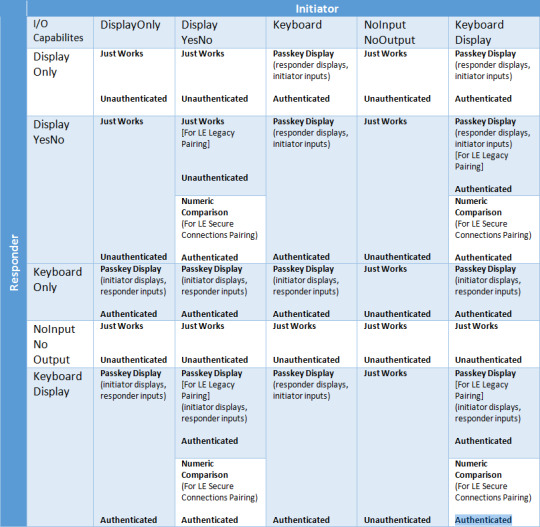
Bonding (Encryption)
After pairing, the two sides will exchange a Long Term Key (LTK) used to generate Session Keys (SK).
Key Strengths
Just Works - Always the same static key. Should not be used!
Passkey Entry - Only 20bits of entropy, can be cracked immediately. Should not be used!
Out of Band - Depends on implementation. Should be verified.
Secure Connections - Uses Elliptic Curve Diffie-Hellman. Very secure.
More than likely that the Bonding won't be used; either Legacy Pairing (weak) or Secure Connection (strong). Instead you'll be able to read or write directly to the characteristic without pairing. If they give a half-thought to security, they will implement their own encryption, without needing pairing or bonding.
Expect this in-house encryption to be worse than Secure Connection (and maybe even Legacy Pairing). Look for ECB mode, repeated nonce values, and other basic mistakes.
Bonding (Encryption) Attacks
Anything but a key generated from Secure Connection is likely to be crackable.
Spoofed the peripheral and tell the host it doesn’t have the key and get the OS do unauthenticated unencrypted communications
Spoof the peripheral and tell the host it doesn’t have the key to get the OS to unpair and repair with the spoofed peripheral
Bluetooth Addressing
Public The TXadd or RXadd bit is 0 Most Significant 24bits Company ID Least Significant 24bits Company Assigned
Random The TXadd or RXadd bit is 1
Random Address modes
Static: changes on bootup Most two significant bits set to 3 (11b) The least significant 46 bits are random.
Private Resolvable: can be found. Recommended they change every 15 minutes, and exchange and IRK (Identity Resolving Key) Most significant 2 bits are set to 1 (01b) Next significant 22 bits are random Least 24 bits are hash
Private Unresolvable: changes during runtime Most significant 2 bits are set to 0 (00b) Least 46 bits are random
Techniques
Accessing the Android BTsnoop from Windows
IMPORTANT: If you have the HCI log from one of the devices involved in the bluetooth communications, you do not need an external sniffer. Sniffing Bluetooth is difficult, having the HCI log makes things much easier.
adb shell su –c "'nc –s 127.0.0.1 -p 8872 –L system/bin/tail -f –c +0 data/misc/bluetooth/logs/btsnoop_hci.log'"
adb forward tcp:11233 tcp:11233
ncat 127.0.0.1 11233 > output.pcap
Setting up Bluetooth Virtual Sniffer in Windows
Download the Microsoft Bluetooth Test Package. It installs in C:\BTP. Look for btvs.exe found in C:\BTP\[version]\x86\
Simply running it will launch wireshark and everything is automagic
Emulation + Sniffing
If you can't control either endpoints, such as a device to device network, then use nRF Connect to emulate one endpoint, and then use the Android BTsnoop to observe how the other device communicates with it. Then use this knowledge to emulate the other device and repeat.
<add steps on how to completely emulate a BLE device using nRF Connect>
Wireshark Tips
Filters:
"btsmp" filters for pairing
"btatt" filters traffic only being sent over the air
"bthci_acl" filters for pairing and data sent over the air
"bthci_cmd.le_long_tem_key" filter shows device setting up BLE encryption
"btsmp.id_resolving_key" gets the IRK key for resolvable addresses
Find streams (hidden serial ports) and export them to json, and have a script parse the json
Assorted Tactics
Bluetooth Sniffing with UbertoothOne Its highly recommended that you use 3 Ubertooths (Uberteeth?) to avoid missing packets.
Using Multiblue <check to see if this is a useful tool>
Challenges
Despite the name, I did not find these CTFs useful for learning security attacks, but they are a known behavior for checking new tools against.
ble_ctf
ble_ctf_infinity
0 notes
